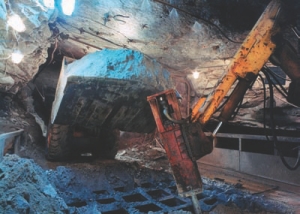VANCOUVER–Gold and silver explorers will need to focus on “best-of- breed” mineral deposits, commodity experts told delegates at Roundup 2010, a recent conference sponsored by the Association for Mineral Exploration British Columbia (AME BC).
Gold
Bigger is better in the gold business, says Jay Hodgson, citing the “80/20 rule” whereby the largest 20% of deposits contribute 80% of the total gold produced. But among gold deposits hosting more than three million oz., he says none of the four main deposit types dominate, excluding outliers such as South Africa’s Witwatersrand. Simply put, no single deposit type — epithermal, sediment-hosted, greenstone or porphyry (intrusive- related) — has a tendency to be larger or more abundant than the others, which means exploration companies seeking a large gold deposit need not favour one particular deposit environment over another.
Prospectors have long known that most gold deposits occur in clusters and that the best place to find new mines is “in the shadow of the headframe” of old mines. A similar theory applies to emerging areas with extensive evidence of historic mining. Hodgson says the exploration record shows that most new gold discoveries are made within or near the boundaries of mineral-rich domains.
“The largest deposits occur in large, highly endowed domains,” Hodgson says, citing Canada’s Abitibi belt and America’s Great Basin as examples.
Hodgson believes these exceptional domains still have good discovery potential.
“Nevada is still a hot area with plenty of places to look for big deposits that aren’t too deep under cover,” he adds. “And new discoveries are still being made in the Abitibi belt, where it’s possible to find another Hollinger or McIntyre.”
Hodgson says another benefit of exceptional, regional-scale gold domains is that they have multiple mining camps and deposits of different types and age. More than 200 million oz. gold have come from the Abitibi, which hosts both types of greenstone gold deposits as well as some of the largest gold-rich volcanogenic massive sulphide (VMS) deposits in North America, notably the Horne and LaRonde mines in Quebec. Giant deposits in the Great Basin of the Western States account for 420 million oz. gold, with many continuing to generate resources. This renowned gold province hosts multiple giant sediment-hosted (Carlin-type) epithermal (Round Mountain) and porphyry deposits (Bingham Canyon) as well as many smaller intrusion-related deposits.
World-class gold belts also occur in other parts of the world, notably Australia and West Africa.
As for lesser known or under-explored areas, Hodgson believes that the Philippines, Papua New Guinea and other parts of Southeast Asia are highly prospective, along with the James Bay Lowlands (northern Canada), developing gold belts in Central Mexico, and the Cordilleran trend from Tierra del Fuego to Alaska.
“Also Colombia, which is opening up, and Venezuela, if it ever grows up,” he adds.
Hodgson advises juniors not to pursue only large deposits as size constraints reduce the number of available targets and increase exploration costs. “Focus on the most abundant deposits because there are more of them waiting to be found.”
Silver
Robert Quartermain, former president of Silver Standard Resources (SSO-T, SSRI-Q), says epithermal deposits are still prime exploration targets for silver-seekers, despite increasing silver output from large base metal mines. Quartermain says most juniors are exploring for epithermal deposits in historic mining districts in the New World, which have collectively produced several billion oz. of silver over five centuries, far surpassing the epithermal silver mines exploited during ancient times in Europe and the Mediterranean region.
“Most of these colonial-era silver camps are still producing today,” Quartermain says, noting that Mexico and Peru now rank as the world’s top two silver producers.
Six of the top 12 silver producers in 2008 were epithermal deposits, with intermediate and lowsulphidation deposits being more productive than high-sulphidation epithermal deposits primarily mined for gold.
But Quartermain says large base metal deposits are contributing increasingly to global silver output, which rose to 707 million oz. in 2008 from about 450 million oz. in 1988.
While primary silver mines are geologically rare, most types of base metal deposits have potential for significant silver production, including sediment-hosted stratiform, VMS, sedimentary exhalative, large porphyry copper deposits and magmatic nickel-copper deposits.
This geological diversity is reflected in Quartermain’s list of top-five silver producers of 2008: BHP Billiton’s (BHP-N) Cannington lead-zinc-silver mine in Australia; the Fresnillo silver-lead-zinc-gold mine in central Mexico; the San Cristobal silver-zinc-lead mine in Bolivia; and KGHM’s Rudna and Lubin copper mines in Poland.
Quartermain says various subtypes of stratiform base metal deposits, such as the giant Kupferschieffer-type copper deposits in western Poland and eastern Germany, were among the most significant silver producers of the past 50 years and will continue to be “significant producers of silver for years to come.”
What does all this mean for future silver prices given that the last post-war (1950s) base metal boom had depressed silver prices for decades? Quartermain sees potential for silver’s strength beyond its recent revival, which owes much to investment interest in silver exchange-traded funds (ETFs) as an affordable safe-haven alternative to gold.
“Silver is a green metal and a natural biocide,” Quartermain says, adding that its unique properties are well-suited for many new environmental and medical uses to supplement its recent emergence as a modern-age industrial metal.
–The author is a freelance writer based in Vancouver, and a former editor of The Northern Miner.


Be the first to comment on "Gold, Silver And ‘Mineral Deposits That Matter’"